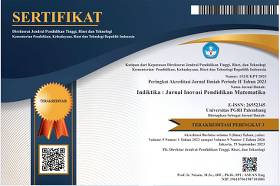Students' Numeracy Literacy Using Artificial Intelligence (AI)-Based Worksheets
DOI:
https://doi.org/10.31851/indiktika.v7i1.17032Keywords:
worksheet, numeracy literacy, artificial intelligenceAbstract
Artificial Intelligence has significant potential to enhance the mathematics learning experience. To fully realize the benefits of AI integration, it is crucial to develop teaching materials that effectively incorporate AI into classroom instruction. This study focuses on developing AI-based student worksheets to improve numeracy literacy skills among junior high school students. These worksheets were created with the support of AI technology and include AI applications that can be used directly during the learning process. Conducted in state junior high schools (SMP) and Islamic junior high schools (MTs) in Palembang, the project followed a series of formative evaluation stages. These stages involved self-evaluation, expert reviews, one-on-one sessions, small group testing, and field testing, alongside product dissemination activities. Data on students' numeracy literacy skills were gathered through interviews and tests, while the analysis process consisted of three key stages: data reduction, data presentation, and drawing conclusions. The findings showed that some students had already grasped the steps to solve problems. Overall, the evaluation results for the numeracy literacy test were categorized as high performance. The AI-based worksheets proved effective in helping teachers deliver engaging teaching materials and enhancing students' learning experiences, particularly in improving their numeracy literacy.
References
Alam, U. F. (2013). Kemampuan Literasi Informasi Mahasiswa dan Peranan Perpustakaan Dalam Proses Belajar Mengajar di Perguruan Tinggi. Pustakaloka, 5(1), 92–105.
Azhar, A., Nuraida, I., Sugilar, H., & Haryadi, N. R. S. (2023). Permasalahan Siswa dalam Memecahkan Masalah Matematika dalam Mengerjakan Soal PISA. Gunung Djati Conference Series, 32, 45–51.
Cennamo, K., & Kalk, D. (2019). Real World Instructional Design: An terative approach to designing learning experiences. Routledge.
Dewi, R. F., Sulistyowati, F., Kusumaningrum, B., Ayuningtyas, A. D., & Sukiyanto, S. (2023). Tingkat Pemahaman Numerasi Siswa SMP dalam Menyelesaikan Permasalahan Konstekstual Berdasarkan Langkah Penyelesaian Polya. SEMANTIK: Prosiding Seminar Nasional Pendidikan Matematika, 1(1), 373–382.
Dinni, H. N. (2018). HOTS (High Order Thinking Skills) dan Kaitannya dengan Kemampuan Literasi Matematika. PRISMA, Prosiding Seminar Nasional Matematika, 1, 170–176.
Feriyanto, F. (2022). Strategi Penguatan Literasi Numerasi Matematika bagi Peserta Didik pada Kurikulum Merdeka Belajar. Gammath: Jurnal Ilmiah Program Studi Pendidikan Matematika, 7(2), 86–94.
Hwang, G.-J., & Tu, Y.-F. (2021). Roles and Research Trends of Artificial Intelligence in Mathematics Education: A Bibliometric Mapping Analysis and Systematic Review. Mathematics, 9(6), 584.
Irawan, E., Aristiawan, A., & Rokmana, A. W. (2021). Analisis Tingkat Penalaran Peserta Didik SMP dalam Memecahkan Masalah Soal Evaluasi Berbasis Literasi Numerasi. Jurnal Tadris IPA Indonesia, 1(3), 333–342.
Kotsis, K. T. (2024). ChatGPT in Teaching Physics Hands-on Experiments in Primary School. European Journal of Education Studies, 11(10), 126–143.
Mittal, U., Sai, S., & Chamola, V. (2024). A Comprehensive Review on Generative AI for Education. IEEE Access, 12, 142733–142759.
Moeloeng, J. (2013). Metologi Penelitian Kualitatif. PT Remaja Rosda Karya.
Mukhlis, S., & Rahayu, Y. S. (2020). Kemampuan Literasi Digital: Penguatan Pendidikan Karakter Sebagai Upaya Menghadapi Era Revolusi Industri 4.0. Dikoda: Jurnal Pendidikan Sekolah Dasar, 1(01), 1–9.
Muliantara, I. K., & Suarni, N. K. (2022). Strategi Menguatkan Literasi dan Numerasi untuk Mendukung Merdeka Belajar di Sekolah Dasar. Edukatif: Jurnal Ilmu Pendidikan, 4(3), 4847–4855.
OECD, O. for E. C. and D. (2023). PISA 2022 Assessment and Analytical Framework. OECD Publishing.
Setiawan, H., Dafik, N., & Lestari, N. D. S. (2014). Soal Matematika dalam PISA Kaitannya dengan Literasi Matematika dan Keterampilan Berpikir Tingkat Tinggi. Prosiding Seminar Nasional Matematika, 244–251.
Shahidayanti, T., Prahmana, R. C. I., & Fran, F. A. (2024). Integrating Ethno-Realistic Mathematics Education in Developing Three-dimensional Instructional Module. Journal of Honai Math, 7(3), 379–400.
Tessmer, M. (2013). Planning and Conducting Formative Evaluations. Routledge.
Thanh, N. C., & Thanh, T. T. (2015). The Interconnection between Interpretivist Paradigm and Qualitative Methods in Education. American Journal of Educational Science, 1(2), 24–27.
Widiyasari, R., & Eminita, V. (2023). Analisis Strategi Penguatan Literasi dan Numerasi Siswa Sekolah Menengah Pertama sebagai Sarana Pendukung Merdeka Belajar. Seminar Nasional Sosial, Sains, Pendidikan, Humaniora (Senassdra), 2(2), 274–283.
Zawacki-Richter, O., Marín, V. I., Bond, M., & Gouverneur, F. (2019). Systematic Review of Research on Artificial Intelligence Applications in Higher Education–where are the educators? International Journal of Educational Technology in Higher Education, 16(1), 1–27.
Downloads
Published
Issue
Section
License
Copyright (c) 2024 Riza Agustiani, Atika Zahra, Agustiany Dumeva Putri, Muhammad Hadi, Aji Marwan, Asna Markhotun Solehah, Anggun Meylani Saputri, Ahmad Sopani

This work is licensed under a Creative Commons Attribution-ShareAlike 4.0 International License.
This work is licensed under a Creative Commons Attribution-ShareAlike 4.0 International License.
Authors who publish with this journal agree to the following terms:
- Authors retain copyright and grant the journal right of first publication with the work simultaneously licensed under a Creative Commons Attribution License that allows others to share the work with an acknowledgement of the work's authorship and initial publication in this journal.
- Authors are able to enter into separate, additional contractual arrangements for the non-exclusive distribution of the journal's published version of the work (e.g., post it to an institutional repository or publish it in a book), with an acknowledgement of its initial publication in this journal.
- Authors are permitted and encouraged to post their work online (e.g., in institutional repositories or on their website) prior to and during the submission process, as it can lead to productive exchanges, as well as earlier and greater citation of published work.












